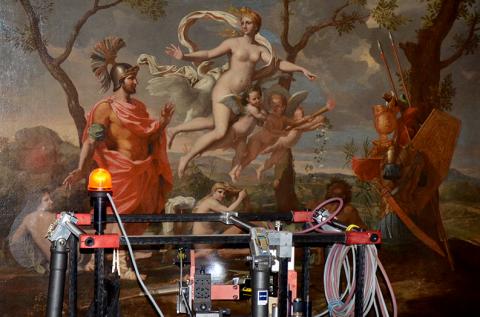
Chemistry, from laboratory to museum
With the Molecular and Structural Archeology Laboratory (LAMS), chemistry comes to the museum.
Created in 2012, this laboratory directed by Philippe Walter pursues research in the chemistry of heritage materials with two goals: to study the evolution of materials used in artistic creation and to analyze the synthesis of ancient components to fuel research and development today.
A chemistry laboratory in the service of art
From prehistoric caves to Ancient Egypt, including easel painting, the LAMS teams look to decipher the processes of artistic creation. Chemists, Egyptologists, philologist, archaeologists, art historian and art restorer work together to unlock the secrets of artist studios.
They study the origin of pigments, the selection of materials, their mixture, the way in which colors and light are represented, using an approach that includes a number of disciplines because there are many clues to understanding the evolution of artistic techniques. "The interdisciplinary and complementary approaches of the laboratory's skills enable us to advance our knowledge of the material history of works of art," says Philippe Walter.
Cutting-edge methods developed in a mobile laboratory
Philippe Walter and his team have developed a highly sophisticated mobile laboratory enabling them to get as close as possible to the works in museums and archaeological sites.
Using measuring instruments that fit in a small suitcase and weigh only a few pounds, these art archaeologists painstakingly excavate the layers of paint. Far from the simple radiography used at the beginning of the 20th century, these new spectrometry* methods enable a great deal of information to be obtained in a short time. "Fluorescence spectrometry helps identify chemical elements, while X-ray diffraction makes it possible to recognize minerals.
With nuclear magnetic resonance, we get information about binders and certain pigments. Finally, thanks to hyperspectral imagery, we are able to see in the infrared and reveal what is under the visible layers,” explains Philippe Walter.
The combination of these different portable and non-invasive devices enables the researchers to discern the fine material composition used in the works.
Building art history through the materials used
The objective is not only to describe the palette of pigments used in a work, but also to build a true history of the materials of art. To do this, scientists develop hypotheses on the aesthetic choices of painters and the evolution of their practices based on years of examination; painting by painting, artist by artist. “We are studying very specific aspects. We look, for example, at the color of the shadows of a garment in the paintings of Nicolas Poussin," says Philippe Walter.
Thanks to measurements made on light and dark areas in the painting, the researchers thus showed that, unlike his predecessors, Nicolas Poussin did not use the same pigment to represent an identical color in shadow and in light. “Before him, Raphael or Leonardo da Vinci added a black glaze over a uniform color to create the shadow area. Nicolas Poussin had, thanks to advances in the field of optics and the understanding of how vision works, understood the distinction that exists between a pigment and its apparent color as we perceive it ", specifies Philippe Walter.
Various collaborations around the world
To work on these paintings, the laboratory has set up numerous collaborations with museums, such as the National Museum of Capodimonte in Naples or the Barberini Palace in Rome. The laboratory also works on archaeological sites such as the tombs from the time of Ramses II in Luxor.
LAMS also collaborates with other structures. Together with the Atelier du Temps Passé specializing in the conservation and restoration of works of art, it founded Lab4art (a non-invasive analysis laboratory-workshop for the authentication of works of art). This structure makes it possible to combine the scientific expertise of the laboratory and the know-how of the workshop to develop innovative methods and provide data useful for the authentication of works of art.
* Spectrometry is the study of how light interacts with matter and helps determine its chemical composition. There are several types of spectrometry that are complementary in the analysis of matter (such as X-ray fluorescence spectrometry, visible and near infrared hyperspectral imaging, nuclear magnetic resonance spectrometry).
Photo credits: Painting by Nicolas Poussin with the instrument
